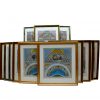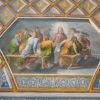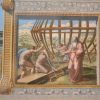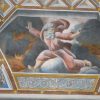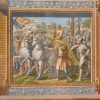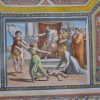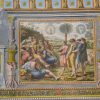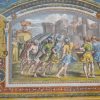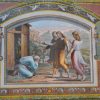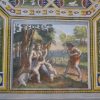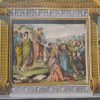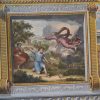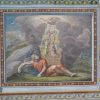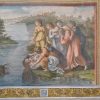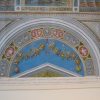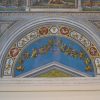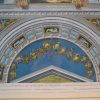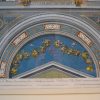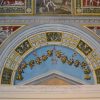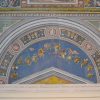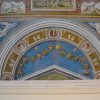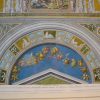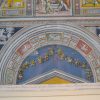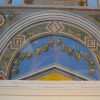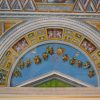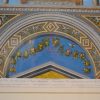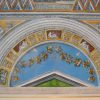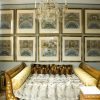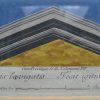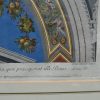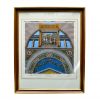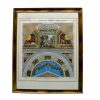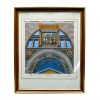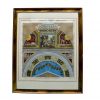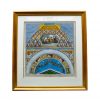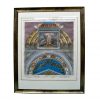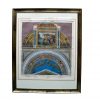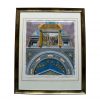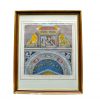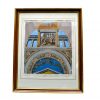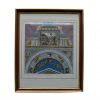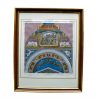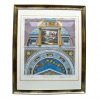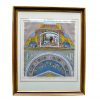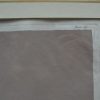Giovanni Ottaviani’s Engravings of Raphael’s Vatican Loggia
$40,000.00
An extremely rare and complete set of all thirteen engravings of the Old Testament frescoes painted by Raphael in a loggia at the Vatican only two years before he died in 1520. Raphael undertook a monumental commission for Pope Leo X: a vaulted arcade within the private apartments of the Vatican. Inspired by recent excavations in Pompeii and the Campagna, Raphael covered the Loggia’s walls and ceilings with painted ornament in the antique style. Like Leonardo and Michelangelo, Raphael was inspired by the rebirth of classical art and learning that characterized the Renaissance. For the Loggia, he created a fascinating mixture of formal and “grotesque” elements (“Grotteschi” were subterranean grottos which the Romans painted as their fancy dictated: shells entwined with beasts, history combined with mythology). The Loggia became known as “Raphael’s Bible,” not only for its Biblical paintings but also for its decorative invention.
The engravings of Raphael’s Loggia were published two and a half centuries later in Rome (1772-1777). One of the most luxurious engraved projects of the 18th century, Le Loggie di Raffaello was the first to reproduce the great frescoes by Raphael and his pupils in the Vatican. It was the result of a collaboration between the painter Gaetano Savorelli, the architect Pietro Camporesi and the engravers Giovanni Ottaviani and Giovanni Volpato, all of whom took active interest in preserving for posterity and making available to contemporaries the splendors of the Vatican. Under the patronage of Pope Clement XIV, this gifted team of artists set out to copy not merely Raphael’s biblical pictures but their wonderful ornamental surrounds, rich in pattern and groteschi. The magnificent engravings that resulted from their collaboration are extraordinarily faithful to Raphael’s originals, even more so because they were hand-colored using gouache, a thicker and more opaque pigment than the more common watercolor that was used to color prints. Vivid and sumptuous, these large-scale works are among the most magnificent engravings to have originated in the 18th century. Beyond their purpose as records of Raphael’s frescoes, these splendid engravings served as inspiration for generations of Neo-Classical artists and designers.
Each of the engravings depicts an important episode found in the Old Testament. The episodes consist of:
The Dreams Interpreted,” Bay VII Scene 1, Copperplate Engraving with Gouache, 1770. The seventh bay represents the adventurous life of Joseph. In “The Dreams Interpreted,” Joseph describes his childhood vision to his bothers, who then decide to sell him as a slave to a caravan of merchants. The remaining scenes in the bay are “Joseph Sold by His Brothers,”
God Appears to Isaac, Bay V Scene 1, Copperplate Engraving with Gouache, 1770. The story of Isaac is the main subject in the fifth bay. “God Appears to Isaac” is the first scene, in which God assures Isaac that he will indeed have descendants. The rest of the scenes in this bay include “Isaac and Rebekah Spied on by Abimelech,” “Isaac Blesses Jacob,” and finally “Isaac and Esau.”
T
he Judgment of Solomon,” Bay XII Scene 2, Copperplate Engraving with Gouache, 1770. The twelfth bay shows the story of Solomon, a peaceful and wise king. The bay begins with “The Consecration of Solomon,” which is followed by “The Judgement of Solomon.” This scene illustrates the link between inherent justice and his kingship. The bay concludes with “The Building of the Temple,” and “Solomon and the Queen of Sheba.”
Jacob’s Dream,” Bay VI Scene 1, Copperplate Engraving with Gouache, 1770. The sixth bay represents the story of Jacob. “Jacob’s Dream” is the first panel in the story, showing him asleep in the desert, with angels ascending and descending a ladder to heaven, and God at the top of the ladder. Jacob’s story continues in the other three panels titled “The Meeting of Jacob and Rachel,” “The Pact with Laban,” and “The Journey to Canaan.”
The Last Supper,” Bay XIII Scene 4, Copperplate Engraving with Gouache, 1770. The thirteenth and final bay is devoted to Jesus. The scenes include, in order, “The Adoration of the Shepards,” “The Adoration of the Magi,” “The Baptism of Christ,” and finally “The Last Supper.” This bay concludes which is know as Raphael’s Bible, which begins with “Ante Legem” (before the law), moves to “Sub Lege” (under the law), and concludes with “Sub Gratia” (in a state of grace).
Moses Presents the Tables of Law, Bay IX Scene 4, Copperplate Engraving with Gouache, 1770. The story of Moses on Mount Sinai is depicted in the ninth bay. The bay begins with “Moses Receives the Tables of the Law,” moves to “The Adoration of the Golden Calf,” then “The Pillar of Cloud.” The last scene, “Moses Presents the Tables of Law,” shows Moses presenting the tablets to the children of Israel and ordering them to build the Ark of the Covenant.
Building of the Ark, Bay III Scene 1, Copperplate Engraving with Gouache, 1770. The third bay engages the story of Noah, beginning with “The Building of the Ark.” This scene shows Noah and his carpenter sons beginning the building of the Ark after God warned Noah of his great flood. The other scenes in the bay include “The Flood,” “The Leaving of the Ark,” and “The Sacrifice of Noah.”
The Creation of Light, Bay 1 Scene 1, Copperplate Engraving with Gouache, 1770. The first bay illustrates the story of Creation. Starting with “The Creation of Light,” God commands there to be light and the process of Creation begins. The bay skips the separation of waters, the firmament, and the creation of plants. The other scenes show “The Seperation of Earth from the Waters,” “The Creation of the Sun and the Moon,” and “The Creation of the Animals.”
The Fall of Jericho,” Bay X Scene 2, Copperplate Engraving with Gouache, 1770. The stages of the conquest of the promised land, along with the story of Joshua, are depicted in the tenth bay. The bay begins with “The Passage of the Jordan,” which leads to “The Fall of Jericho.” In this scene, Joshua causes the walls of Jericho to fall as he enters with the Ark of the Covenant. The bay concludes with “Joshua Commands the Sun and the Moon to Stand Still,” and “The Division of the Promised Land.”
Abraham and the Three Angels,” Bay IV Scene 3, Copperplate Engraving with Gouache, 1770. The fourth bay follows the story of Abraham. The first and second scene, “Abraham and Melchizedek” and “The Promise of Abraham,” lead to “Abraham and the Three Angels” in which Abraham is told by the angels that a son will be born to him. The bay concludes with “The Flight of Lot,” which is a slight departure from Abraham’s story.
The Triumph of David, Bay XI Scene 4, Copperplate Engraving with Gouache, 1770. The eleventh bay illustrates the story of the kings, when Israel attains its apogee. The story skips over Saul, and begins with “The Anointing of David,” followed by the combative scene of “David and Goliath,” with “David and Bathsheba” following. Finally, the bay ends with “The Triumph of David,” who is shown emerging as a victor and heading towards Jerusalem after defeating the many obstacles.
The Finding of Moses, Bay VIII Scene 1, Copperplate Engraving with Gouache, 1770. The eighth bay illustrates the story of Moses. The narrative opens with “The Finding of Moses,” in which the Pharaoh’s daughter discovers Moses on the banks of the Nile River. The bay then moves on to depict other major moments from Moses’s story, including “The Burning Bush,” “The Passage of the Red Sea,” and “Moses Strikes Water from a Rock.”
“The Last Supper,” Bay XIII Scene 4, Copperplate Engraving with Gouache, 1770. The thirteenth and final bay is devoted to Jesus. The scenes include, in order, “The Adoration of the Shepards,” “The Adoration of the Magi,” “The Baptism of Christ,” and finally “The Last Supper.” This bay concludes which is know as Raphael’s Bible, which begins with “Ante Legem” (before the law), moves to “Sub Lege” (under the law), and concludes with “Sub Gratia” (in a state of grace).
The Labors of Adam and Eve, Bay II Scene 4, Copperplate Engraving with Gouache, 1770. The second bay is dedicated to Adam and Eve. The first three scenes are “The Creation of Eve,” “The Fall,” and “The Expulsion from the Garden.” Ending with “The Labors of Adam and Eve,” this scene depicts sowing the land, evocative of promise and hope, and Eve smiling with sons Cain and Abel.
Out of stock


